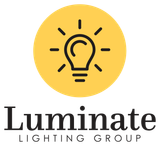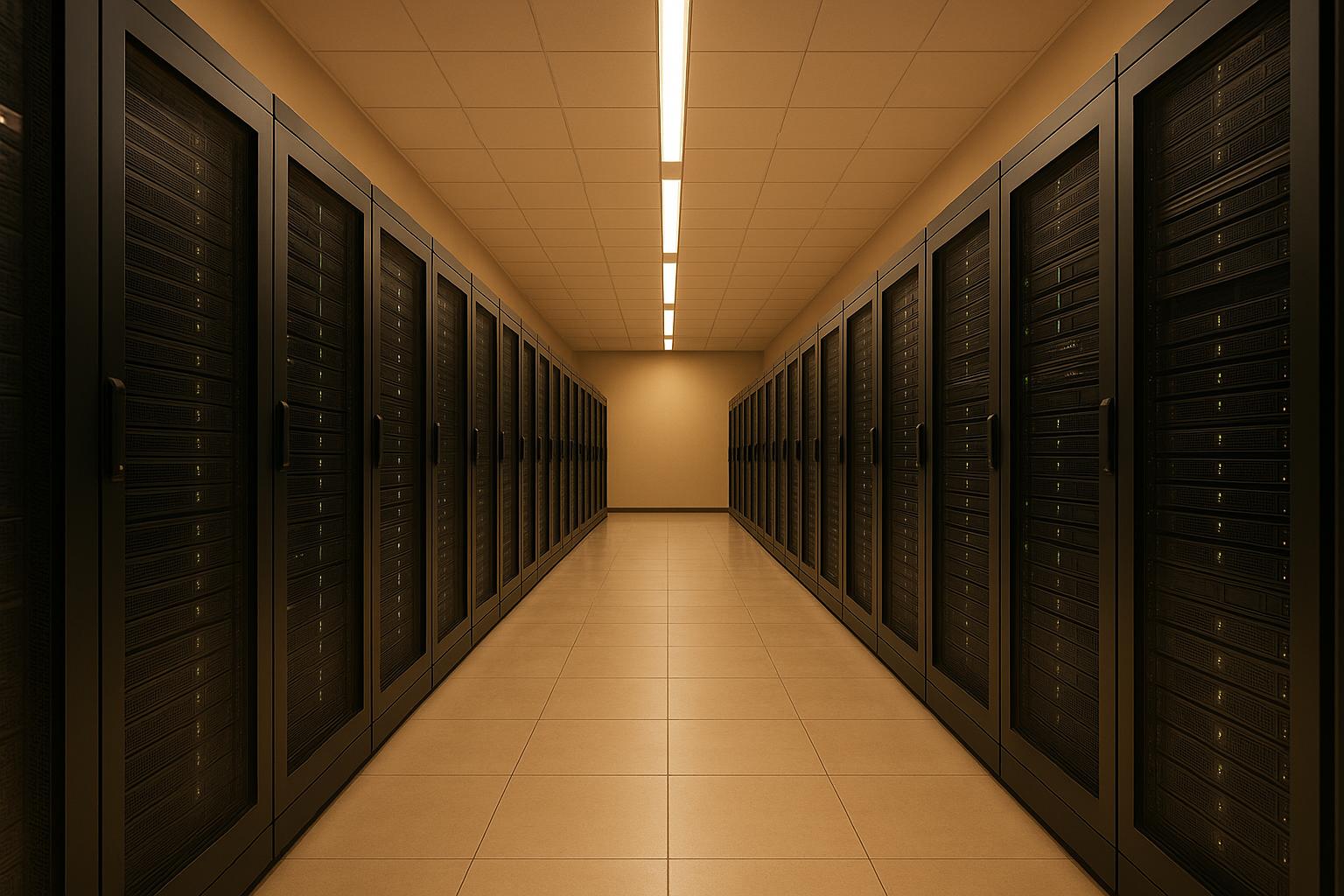Explore how data centers can optimize lighting for energy efficiency and compliance with key energy codes while reducing operational costs.


Data centers consume significant energy, and lighting is a key area to optimize for cost savings and meeting regulatory requirements. Compliance with energy codes like IBC, IECC 2024, ASHRAE 90.1, and California Title 24 helps reduce energy use, lower operational costs, and qualify for tax incentives like Section 179D. Here's a quick breakdown:
Each code has unique strengths and challenges. Operators often need to comply with multiple standards simultaneously, requiring careful planning and collaboration with experts to ensure compliance while balancing costs and energy performance.
The International Building Code (IBC) sets life safety and structural standards across the United States, including essential lighting requirements for data centers. While the code mainly focuses on safety rather than energy efficiency, it lays out critical guidelines to ensure safe egress and emergency readiness in facilities like data centers.
One key requirement is that emergency lighting must activate automatically during power outages, and exit signs must remain illuminated through backup power systems. These measures are designed to facilitate safe evacuation and provide clear, visible routes in case of emergencies.
The IBC also addresses lighting controls, including manual override options. These controls are particularly valuable in complex environments, such as multi-story buildings or areas with raised floors, where quick adjustments may be necessary during maintenance or system malfunctions.
Although the IBC prioritizes safety over energy performance, its provisions serve as a foundation for energy-focused standards. Up next, we’ll examine how the IECC 2024 builds upon these principles to advance energy efficiency in data center lighting.
The IECC 2024 introduces new measures to improve energy efficiency in data center lighting. While building codes like the IBC primarily focus on safety, the IECC shifts attention toward energy performance - an important factor for cutting operational costs. Among its key updates, the code outlines specific Lighting Power Density (LPD) limits, reshaping how lighting is designed in data centers.
One of the standout features of the IECC 2024 is its focus on Lighting Power Density (LPD) limits. These limits set a maximum amount of lighting power allowed per square foot, aiming to reduce overall energy use. Although the exact numerical limits may vary depending on the type of space within a data center, the broader goal is clear: enforce stricter energy standards in high-use areas while allowing flexibility in zones with lower lighting demands. These LPD requirements are a cornerstone for improving energy efficiency and cutting costs in data centers.
Facility managers can align with these new standards by carefully reconsidering their choices in lighting fixtures, their placement, and the amount of light output. This approach not only ensures compliance but also enhances overall energy performance.
For those navigating these changes, expert advice can make all the difference. At Luminate Lighting Group, we specialize in energy-efficient lighting solutions designed to lower costs and improve functionality. Our expertise helps streamline the process of meeting updated LPD requirements while ensuring your facility stays energy-code compliant.
ASHRAE 90.1 outlines energy and lighting efficiency standards specifically tailored for U.S. data centers. Its goal is twofold: to encourage energy conservation while ensuring the operational functionality and safety essential to these critical facilities. This section focuses on how the standard addresses the unique lighting needs of data centers.
ASHRAE 90.1 establishes lighting power density (LPD) limits that reflect the specific demands of different areas within a data center. These zones include computer rooms, server spaces, electrical rooms, and mechanical areas. By defining these categories, the standard helps facility managers design lighting systems that align with each zone's operational requirements. To meet these guidelines, high-efficiency LED fixtures and strategic placement are key for delivering both energy savings and proper illumination.
The standard also emphasizes the importance of lighting controls and automation to further reduce energy use. In spaces with irregular occupancy, systems like occupancy sensors and automated scheduling adjust lighting levels based on real-time usage while maintaining safety protocols.
Emergency preparedness is another critical focus of ASHRAE 90.1. Data centers, with their dense layouts and minimal natural light, require dependable emergency lighting systems. The standard specifies that exit routes and areas around vital equipment must have sufficient illumination during emergencies. Battery backups are a must to ensure lighting reliability during power outages or maintenance periods.
Navigating these complex requirements demands expertise in lighting design. Companies like Luminate Lighting Group specialize in creating solutions that not only comply with ASHRAE 90.1 but also balance energy efficiency with the operational and safety needs of modern data centers.
California Title 24, Part 6, sets the bar high when it comes to energy efficiency standards for data centers and other nonresidential buildings. Updated every three years, these regulations go beyond federal guidelines to align with California's ambitious energy conservation and greenhouse gas reduction goals. Over the next 30 years, these measures are projected to deliver $1.5 billion in consumer benefits while cutting 10 million metric tons of greenhouse gases. For data centers, this means tighter energy controls and precise management to meet these demanding standards.
"The intention of Title 24 is to help uncover energy inefficiencies where energy grid usage is more than it needs to be." - Curtis Worley, EVP of Pacific Test and Balance, Inc.
Title 24 enforces stricter Lighting Power Density (LPD) limits than national standards. These limits specify power density requirements, measured in watts per square foot, for areas like computer rooms, electrical equipment spaces, and support areas. While lighting isn't the biggest energy consumer in a data center, it’s one of the easiest areas to improve for better energy efficiency.
The code also requires advanced control systems to optimize energy use. These systems include features like time-switch controls, occupant sensors, daylighting integration, and dimming capabilities, all designed to balance energy savings with operational safety.
To minimize unnecessary energy consumption, emergency indicator lights are capped at a maximum of one watt each.
California’s compliance process is particularly stringent:
"Title 24 isn't about making it work. It's about proving that it does." - Amber Kelly, TAB Superintendent at ACCO Engineered Systems
Navigating Title 24’s complex requirements can be challenging, but with the help of experienced lighting professionals, data centers can achieve optimal energy performance while taking advantage of available incentives.
Each energy code comes with its own set of strengths and challenges, and facility managers need to weigh these trade-offs carefully. Balancing standards and addressing overlapping requirements is crucial for effective decision-making.
The International Building Code (IBC) is widely accepted across U.S. jurisdictions, making it a dependable choice for multi-state operations. Its primary focus on safety ensures consistent emergency lighting and egress standards. However, its provisions for energy efficiency are minimal, often requiring additional standards to fill the gaps.
IECC 2024 delivers notable energy savings with updated limits for lighting power density and advanced control requirements. On the flip side, its numerous exceptions, trade-offs, and complex calculation methods can be overwhelming for teams, especially without specialized training.
ASHRAE 90.1 is known for its technical depth and industry credibility. It provides detailed guidance on lighting controls and power management. That said, its complexity can lead to higher compliance costs, particularly for smaller facilities that may lack the required expertise.
California Title 24 stands out with its stringent energy performance standards and integration with utility incentive programs, which can help offset costs. However, its rigorous requirements and extensive documentation demands can create significant administrative burdens.
Here’s a quick comparison of the advantages and disadvantages of these energy codes:
| Energy Code | Key Advantages | Primary Disadvantages |
|---|---|---|
| IBC | Broad adoption, consistent safety standards, simple compliance | Limited energy efficiency focus, needs supplemental standards |
| IECC 2024 | High energy savings, updated tech requirements, flexible paths | Complex calculations, frequent updates require ongoing training |
| ASHRAE 90.1 | Precise guidelines, strong industry reputation, detailed controls | High compliance costs, requires specialized expertise |
| California Title 24 | Top-tier energy efficiency, utility incentives, innovative standards | Administrative complexity, limited to California |
In many cases, multiple codes apply simultaneously. For instance, data centers in California often need to comply with Title 24, IBC, and sometimes ASHRAE 90.1. These overlapping requirements can create conflicts, demanding careful engineering analysis to resolve.
Both ASHRAE 90.1 and Title 24 may require higher upfront investments, but these costs are often offset by long-term savings. Meanwhile, IECC 2024 offers a more streamlined approach to efficiency gains, with less administrative burden.
For data center operators, the challenge lies in identifying the right combination of codes for their specific needs. Leveraging professional expertise is essential to optimize compliance strategies while balancing performance and cost. Luminate Lighting Group’s experience with energy code requirements helps facilities navigate these complexities, ensuring both compliance and operational efficiency.
Navigating compliance with energy and safety codes like ASHRAE 90.1, California Title 24, IECC 2024, and the IBC requires a thoughtful and integrated approach. These standards often overlap, and aligning them effectively can lead to better efficiency and noticeable energy savings. Instead of treating these codes as isolated requirements, combining their strengths can result in smarter, more sustainable solutions.
For example, data centers often face the challenge of meeting multiple code requirements at once. Using advanced lighting controls - like automated dimming and occupancy sensors - not only helps ensure compliance but also enhances long-term performance and operational efficiency.
The key to success lies in early planning and making smart technology choices. Working with experts like Luminate Lighting Group can make a big difference. They offer energy audits, custom LED designs, and help with utility rebates and 179D tax deductions. By combining detailed code analysis with strategic LED upgrades, operators can achieve lasting energy savings and streamlined compliance.
As energy codes continue to push for greater efficiency, investing in forward-thinking, adaptable lighting solutions ensures that facilities remain compliant while optimizing costs and performance for years to come.
The IECC 2024 prioritizes automatic lighting controls and daylighting strategies to improve energy efficiency. It outlines clear guidelines for lighting power density (LPD) and control systems, aiming to balance adaptability with sustainable lighting practices.
ASHRAE 90.1 offers an alternative to the IECC, providing detailed technical standards for automation. This includes tools like occupancy sensors and advanced lighting controls, making it a popular choice for commercial buildings focused on energy-efficient solutions.
Meanwhile, California Title 24 takes a more specific and climate-oriented approach. It enforces stricter rules on lighting power allowances, the use of occupancy sensors, and advanced daylighting controls. Its prescriptive method aligns with California’s ambitious energy-saving objectives, positioning it as one of the toughest codes in the country.
To navigate the complexities of overlapping energy codes for data center lighting without inflating costs, it’s essential to stay current with key standards such as ASHRAE/IES 90.1 and the IECC. These standards set clear benchmarks for energy-efficient lighting and control systems in commercial spaces.
Collaborating with specialists like Luminate Lighting Group can make this process much more manageable. They provide customized solutions like energy-efficient LED retrofits, tailored lighting designs, and comprehensive energy audits. These services not only help you comply with code requirements but also lower energy costs and improve lighting performance - all while aligning with your sustainability objectives.
Advanced lighting controls play a key role in helping data centers meet energy codes while improving efficiency. Tools such as occupancy sensors, daylight sensors, and automated dimming systems ensure lighting is used only when necessary, cutting down on energy waste.
These systems also work seamlessly with protocols like DALI and 0-10V, enabling automated and precise control over lighting. By implementing these technologies, data centers can reduce utility expenses, improve operational performance, and contribute to sustainability efforts - all while staying compliant with stringent energy regulations.